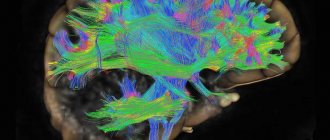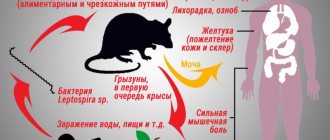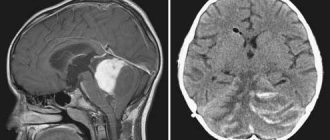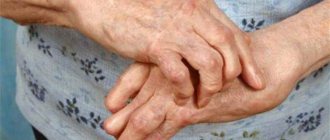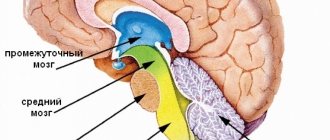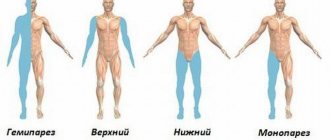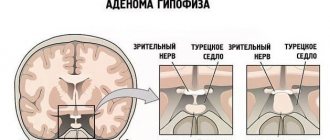| Simple type of schizophrenia | |
| ICD-10 | 20.620.6 |
| ICD-9 | 295.0295.0 |
A simple type of schizophrenia
(or
a simple form of schizophrenia
[1][2],
simple schizophrenia
,
simplex schizophrenia
) is a mental illness in which there are mainly negative schizophrenic symptoms (such as apathy, abulia, affective flattening). It usually develops in adolescence or adolescence (14-20 years), that is, later than hebephrenic and catatonic, but earlier than paranoid[3].
Description
Patients are characterized by premorbid personality traits such as shyness, timidity, fearfulness, infantilism[4], as well as pronounced schizoid traits - from excessive sensitivity and vulnerability to apathy, coldness and “affective dullness”[5].
At the beginning of the course of the disease, mental disorder is expressed in an intensification of features reminiscent of character accentuation, and then a distortion of the features occurs [5]. The personality of diligent, obedient, polite teenagers suddenly changes: they become rude in communication, lose feelings for close relatives or even begin to show hatred and unreasonable cruelty towards them, stop attending classes, lie aimlessly on the bed and feel indifference to useful activities, sleep for a long time or wander, neglect the rules of hygiene and do not take care of their clothing[4]. The voice becomes monotonous, and facial expressions and motor skills are inexpressive.
Instead of productive activities, many patients begin to think about abstract topics, for example, about the problems of the universe, the meaning of life and death, and immerse themselves in the study of philosophy, linguistics and other theoretical sciences, for which they usually have no preparation, which can be considered as a symptom of metaphysical intoxication [4 ]. The patient may be engaged in constructing theories of philosophy divorced from reality, solving intricate mathematical problems, aimless invention, collecting unnecessary things, etc. [5].
Persistent hallucinations and delusions are usually absent in the simple form of schizophrenia, but such symptoms may appear over time. Catatonic or affective disorders appear less frequently[6]. Productive psychotic symptoms are also possible at the beginning of the disease, at its debut: unstable delusional ideas of persecution, relationship and special meaning may be observed [7], but after a short time it is reduced. Some researchers claim that delusions and hallucinations do not occur at all[3], only rudimentary hallucinatory disorders (“hailing”) and episodic delusional alertness may appear[4]. Adynamic depression is often observed [ source not specified 607 days
], senestopathy and dysmorphophobia[5].
Neurocognitive deficits in simple schizophrenia include memory impairment, absent-mindedness, difficulty planning activities, and poor judgment[5].
Thinking disorders may be present (“formal thinking disorders” [8], “disorders of the associative process” [9], “disorders of the thinking process” [10]). This manifests itself in impoverished speech, interruptions in the associative process (the so-called “sperrungs”), and unintentional slippage from the topic. There may be a feeling of openness of thoughts (when other people allegedly can see or hear the thoughts of patients), delay, disappearance, influx or insubordination of thoughts [3]. Stereotypes may also appear: swaying, gestures, coughing, which some researchers refer to as erased catatonic symptoms[11]. Vague hypochondriacal complaints may be present[3].
The initial period of the disease is characterized by a predominance of psychopathic-like (36.8%), neurosis-like (29%) and apatho-abulic (34.2%) symptoms [12][5]. Subsequently, there is an increase in apato-abulic syndrome and a decrease in energy potential, an increase in the phenomena of mental automatism, and the formation of a mental defect [6] [3].
Close relatives of the patient may not notice the manifestations of the disease and consider them to be a bad character or laziness[13]:18.
What is progression?
The term is used in psychiatry and means the development of a mental illness with a gradual increase in negative and positive symptoms. In other words, this concept describes the course of diseases such as epilepsy, Alzheimer's disease, schizophrenia and senile dementia, which have pronounced phases of exacerbation and remission with an increasing deterioration of the patient's condition in the future. In addition, the progressive course of a mental illness can occur not only in the form of sinusoidal phases of improvement and exacerbation, but also in the form of a continuous and steady deterioration in well-being.
Classification
ICD-9
In the International Classification of Diseases, Injuries and Causes of Death, 9th Revision (ICD-9), a simple type of schizophrenia (code 295.0295.0) is described as “psychosis in which there is a fairly rapid development of strange behavior, a decrease in the ability to meet the demands of society and a weakening of the general activity"[14]. The classification also notes that hallucinations, delusions and other psychotic disorders are not as severe as compared to paranoid, hebephrenic and catatonic schizophrenia. With increasing social maladaptation, the patient may begin to engage in vagrancy. Characterized by inactivity, aimlessness and autism.
The need for careful diagnosis of this form of schizophrenia is noted, since its symptoms are not clearly defined.
Excluded: sluggish simple schizophrenia (code 295.52295.52).
ICD-10
The diagnosis of simple schizophrenia according to the International Classification of Diseases, 10th revision, is made when negative symptoms of schizophrenia (flattening of affect, loss of motivation) in the patient are increasing, accompanied by an increasing inability to meet the demands of society, the development of oddities in behavior and a decrease in overall productivity [15]. In this case, delusional disorders and hallucinations should not be observed[15]. The simple variant of malignant schizophrenia and simplex schizophrenia are included, and “symptom-poor” schizophrenia is excluded (21..5)[15].
To diagnose simple schizophrenia according to ICD-10, the following criteria must be met:
- A. Slow progressive development over at least a year of all three signs:
- a distinct change in premorbid personality, manifested by loss of drives and interests, inactivity and aimless behavior, self-absorption and social withdrawal;
- the gradual appearance and deepening of “negative” symptoms, such as severe apathy, impoverished speech, hypoactivity, emotional flatness, passivity and lack of initiative and poverty of non-verbal communication (determined by facial expression, contact in the gaze, voice modulation or posture);
- a distinct decrease in social, educational or professional productivity.
- B. Absence at any time of abnormal subjective experiences, as indicated in G1 in F20.0-F20.3, as well as hallucinations or sufficiently fully formed delusions of any kind, that is, the clinical case should never meet the criteria of any another type of schizophrenia or any other psychotic disorder.
- C. No evidence for dementia or other organic mental disorder as presented in section F0.
Original text (English)
- A. Slowly progressive development over a period of at least one year, of all three of the following:
- A significant and consistent change in the overall quality of some aspects of personal behavior, manifest as loss of drive and interests, aimlessness, idleness, a self-absorbed, and social withdrawal attitude.
- Gradual appearance and deepening of “negative” symptoms such as marked apathy, paucity of speech, underactivity, blunting of affect, passivity and lack of initiative, and poor non-verbal communication (by facial expression, eye contact, voice modulation and posture).
- Marked decline in social, scholastic, or occupational performance.
- B. Absence, at any time, of any symptoms referred to in G1 in F20.0—F20.3, and of hallucinations or wellformed delusions of any kind, ie the subject must never have met the criteria for any other type of schizophrenia, or any other psychotic disorder.
- C. Absence of evidence of dementia or any other organic mental disorder listed in section F0.
— International Classification of Diseases, 10th revision. Research diagnostic criteria[16]
A. Kalinovsky identifies the following diagnostic criteria for a simple type of schizophrenia[17][3]:
- a) decrease in overall activity and initiative;
- b) gradual loss of interests;
- c) autism;
- d) violation of contact with other people, up to self-isolation;
- e) formal thinking disorders;
- f) affective disorders (impoverishment and inadequacy of emotions);
- g) ambivalence;
- h) lack of criticism towards painful manifestations.
Flow options
Designation of types of disease according to ICD-10:
- continuous F20.60
- episodic with increasing defect F20.61
- episodic with stable defect F20.62
- episodic relapsing F20.63
Incomplete remission is indicated by the code F20.64, and complete remission by F20.65.
Differential diagnosis
Schizoid personality disorder and demyelinating sclerosing leukoencephalitis should be excluded. Differential diagnosis of simple schizophrenia from character accentuations and personality disorders can present certain difficulties [5].
DSM
“Simple type of schizophrenia” (eng. schizophrenia, simple type, code 295.0) was present in the second edition of the American “Diagnostic and Statistical Manual of Mental Disorders” - DSM-II in 1968 [18]. It described it as “a psychosis characterized by a slow and silent decline in external attachments and interests, apathy and indifference, leading to the impoverishment of interpersonal relationships, intellectual degradation and adaptation to a lower level of functioning”[18]. A contrast has also been noted with schizoid personality disorder, in which there is little or no progression of symptoms[18].
The DSM-III and DSM-III-R do not mention simple type schizophrenia.
In DSM-IV and DSM-IV-TR, simple schizophrenia is not a recognized diagnosis, but Appendix B lists "a set of criteria and axes provided for further study" where simple schizophrenia is mentioned, called "simple progressive disorder." simple deteriorative disorder (simple schizophrenia)[19][20].
The criteria for simple progressive disorder were as follows[19]:
- progression of the disorder for at least 1 year;
- a noticeable decline in professional or academic productivity;
- poor interpersonal relationships and social isolation;
- the gradual appearance and worsening of negative symptoms, namely affective flattening, lack of will and alogia;
- does not meet criteria “A” for schizophrenia (presence of 2 or more of the following symptoms simultaneously: delusions, hallucinations, disorganized speech, grossly disorganized or catatonic behavior, negative symptoms);
- schizotypal and schizoid personality disorder, psychotic disorder, affective disorder, anxiety disorder, mental retardation and dementia were excluded;
- the condition is not caused by the direct physiological effects of the substance or by a general medical condition.
The DSM-5 does not include this disorder. In the latest edition of the Diagnostic and Statistical Manual of Mental Disorders, a similar (but not identical) disorder according to the criteria is schizotypal personality disorder.
Periodic or circular form
Characterized by single depressive and manic attacks. It happens that double attacks are observed, that is, one type of course replaces another.
If there is schizophrenia, the fur-like course in this form resembles depressive psychosis. The very first attacks are practically indistinguishable from it. Subsequent ones already occur with the following symptoms:
- Ideas of persecution appear.
- Fantastic nonsense.
- Catatonic disorders.
- A cheerful mood can be replaced by stupid behavior and foolishness, and the desire for work can be replaced by disinhibition.
Therapy for the disease may vary depending on the form of the pathology, so any decision on this matter should be made only by a doctor.
Course and variants of simple schizophrenia
Like hebephrenia, the simple type of schizophrenia usually begins in adolescence and young adulthood. The course is slow, continuously progressive, the onset of remission is almost impossible to establish. Many psychiatrists note that the malignant course of the simple type of schizophrenia is much less common than the flaccid course [5].
There are also psychopathic-like and neurosis-like types of course[3]. Some researchers identify other variants of the simple type of schizophrenia: “psychopath-like”, which debuts in adolescence and “pseudo-oligophrenic”, which develops in childhood[21][5].
Causes of the disease
The pathogenesis of schizophrenia as a whole has not been fully studied to date. A significant factor in the development of the fur-like form is considered to be genetic and constitutional factors. A more aggressive course was observed in men than in women. For most, the pathology begins to develop in adolescence, as a result of which it acquires a malignant nature after some time and often leads to dementia.
Also factors that can influence the first manifestations of the disease are considered to be:
- suffered severe stress;
- infectious diseases with complications on the brain;
- effects of toxic substances on the nervous system.
Therapy
For simple types of schizophrenia, small doses of antipsychotic drugs are used, as well as insulin comatose therapy [22]: 163 (although it is sometimes argued that insulin comatose therapy can worsen the condition of simple schizophrenia [23]).
For simple malignant schizophrenia, clozapine can be used[24]. Long-term use of clozapine provides a slight smoothing of negative symptoms and slows down the course of the disease [24]. Second-line drugs for the treatment of simple malignant schizophrenia are the new generation atypical antipsychotics[24]. Atypical new generation antipsychotics do not cause pronounced inhibitory effects and extrapyramidal effects, so their use usually does not cause the development of secondary negative disorders [24]. However, the ability of atypical antipsychotics to reduce the severity of primary negative symptoms still does not have reliable evidence[24].
With the use of quetiapine, improvement in the condition of patients was most often observed [24]. The literature describes cases where the use of quetiapine, risperidone and amisulpride in patients with a simple type of schizophrenia caused revival and some activation [24].
Studies have shown the effectiveness of dopamine's immediate precursor, levodopa, in the treatment of simple schizophrenia[25]. When taking it, patients had a decreased tendency to isolation, apathy, emotional alienation, and flattened affect, while no additional productive symptoms were caused [25].
The use of traditional/typical antipsychotics (haloperidol, chlorpromazine, etc.) is not recommended due to the likelihood of increasing the severity of negative symptoms[24].
Periodic or circular form
Characterized by single depressive and manic attacks. It happens that double attacks are observed, that is, one type of course replaces another.
If there is schizophrenia, the fur-like course in this form resembles depressive psychosis. The very first attacks are practically indistinguishable from it. Subsequent ones already occur with the following symptoms:
- Ideas of persecution appear.
- Fantastic nonsense.
- Catatonic disorders.
- A cheerful mood may be replaced by stupid behavior and foolishness, and the desire for work may be replaced by disinhibition.
Therapy for the disease may vary depending on the form of the pathology, so any decision on this matter should be made only by a doctor.


